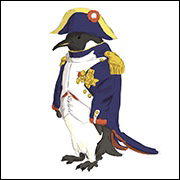|
Oh, and as for other AEG stuff, I have a ton of experience with 7th Sea, both the CCG and the tabletop RPG. My buddies and I ran so many games of that between 2001 and 2010 that a couple of us put together all of the house rules, additions, and subtractions that we had been using from first edition. I put it all together into an unofficial "second edition" years before the game got an actual, overdue, second edition. We still use our own version, and I'm actually running a short campaign of it right now. Unfortunately, like many of the games I could post about in here, I sold off all of my 7th Sea cards a while back. I'll still write up an effortpost about it at some point though. It was a good game, with some flaws for sure, but that seems to be the pattern with pretty much every CCG.
|
|
|
|

|
| # ? May 30, 2024 00:08 |
|
That L5R write up has me clicking the "Would you like to know more?" popup from Starship Troopers. Never played it but a few friends tried it briefly.Railing Kill posted:7th Sea One of my guys was always a big 7th Sea guy, but I never tried it. As I read more and more nautical memoirs and fiction, I am increasingly feeling like I missed out. Did you hear there's plans for a revival? Also, this somehow reminded me of the Decipher Lord Of The Rings Trading Card Game. I played that once. It was cool. Someone should do a write up about that.
|
|
|
|
Magnetic North posted:
|
|
|
|
I had forgotten the Eye of Hazimal tournament. I have so many copies of that stupid Lambach.
|
|
|
|
It's funny since canonically Lambach is a giant wuss who gets pushed around by everyone.
|
|
|
|
Railing Kill posted:Oh, and as for other AEG stuff, I have a ton of experience with 7th Sea, both the CCG and the tabletop RPG. My buddies and I ran so many games of that between 2001 and 2010 that a couple of us put together all of the house rules, additions, and subtractions that we had been using from first edition. I put it all together into an unofficial "second edition" years before the game got an actual, overdue, second edition. We still use our own version, and I'm actually running a short campaign of it right now. I am 100% certain it's also better than the actual second edition that got published. We're getting into the weeds but I'd love to know the house rules and such you came up with. The CCG I played a lot initially, although it fell off much quicker than L5R did around here. I did remember hearing at the big GenCon tournament the head story writer (I think Ree Soesbee) dressed as a Fate Witch and whomever was the last of their faction eliminated she told them what would have happened and then tore up the envelope they would have gotten if the faction won. (I think Sea Dogs won, but don't quote me.)
|
|
|
|
LEGEND OF THE FIVE RINGS, PART TWO: The Rules of Imperial Edition  Before I get too far ahead of myself, let’s talk about how the game initially worked.  Unlike Magic or most other early CCGs, L5R had two decks. (Kind of like Rage, which came out mere months before L5R and, according to Mr. Williams, had some big other innovations that changed his later designs, like simultaneous turns.) The first, the Dynasty deck, had black card backs and contained your primary game pieces: your Personalities (similar to creatures in MtG), Holdings (mostly resource generators, like MtG’s lands), and Events. The second, the Fate deck, had green card backs and containedmore temporary resources and modifiers in action cards, as well as items, spells, and followers to place on your personalities. They would later add a few other card types (regions in the Dynasty deck) being the most important. The fate deck also could contain the Ring cards, which allowed an alternate victory condition where you won immediately by having all five rings in play. When you played, you had access to both your dynasty and fate cards simultaneously, though the method in which you drew them and the times you could play them were different.  You may notice that there are multiple card backs in this picture. Around 1999 or so, the International Olympic Committee sued the owners of L5R since the card backs had five interlocking rings, despite being laid out in a different shape. They changed the back with the final set of the second “arc” of the game, with each starter deck including free sets of sleeves for both dynasty and fate decks to help people with mismatched cards. They were surprisingly sturdy, I used some of them for my playtest decks for over a decade. Later cards had the faces change in design, with two major overhauls over the history of the game. When the game first started, you needed 30 cards in each deck. There weren’t many deckbuilding limitations. You were limited to 3 copies of any given card, with “Unique” and Event cards limited to single copies. You weren’t limited to cards of any single faction, though personalities of the faction you used were cheaper. Each starter deck was themed to a single faction, and the first base set, Imperial, had six factions (the initial six “Great Clans”). Almost every set in the game’s history included new starter decks, with the number of legal clans expanding and contracting over the history of the game. Every starter deck included a Stronghold: these were cards that started in play and determined your clan and your initial capabilities. At first, strongholds were printed on the back of the starter deck boxes, which led to the slang term “box” for your stronghold throughout the game’s existence.  The stronghold shown here, the Ancestral Halls of the Lion, was from the first base set, Imperial Edition. It had 3 main stats, in order from top to bottom: Province strength – this is how tough your provinces were. Unless otherwise noted, each player started with 4 provinces, and they were your “hand” of dynasty cards. To destroy a province, your army needed to have more Force than your opponent’s army + the province strength. Losing a province meant you got access to fewer cards, and losing all four lost you the game. In the initial arc, 6 was more or less the standard for military-focused clans, with the Crab having more in the first set, and the less militarily robust clans having to make do with only 5. Province strength (like personality stats) inflated a bit over the course of the game. Gold Production – rather than getting to play resources for free, most holdings (which were your main economic resource) in L5R had gold costs. You could bow (aka tap, aka turn sideways) your stronghold at any time to make gold equal to its production, which allowed you to buy holdings, which in turn let you buy more holdings and other cards. The first couple of turns were usually spent trying to build your economy, but some clans (like the Lion) would jump start by using their stronghold to buy personalities. Personalities that could be bought just with your stronghold were nicknamed “boxable.” Any excess gold from cards couldn’t be split up (the excess was “taxed”)– if you had a card that cost two gold and another that cost one gold, you couldn’t buy both with your stronghold. They apparently changed that part of the system late in the game’s life, I wouldn’t know, because I quit in part because they kept changing fundamental parts of the game’s systems. The Lion Clan were on the low end of gold production for the game’s history, and the poorest clans to start even in Imperial – another clan, the Phoenix, also had only 3 gold production, but could produce 5 (or more) gold for specific types of cards. Most clans had 4 production in the first arc, with the Unicorn able to make 5.  . Starting Honor – Honor was a sliding track that could go positive or negative over the game, depending on your actions in play, and was key to two of the other victory conditions. 6 was the highest for the first arc, and the Lion Clan consistently started with the highest honor throughout the game’s history. With the early card sets, high honor could be a bit of a disadvantage at times, but eventually your starting honor (plus modifiers, at different parts of the game’s history) determined whether or not you would go first. When we discuss victory conditions, we will see how this was an enormous advantage and the high honor clans (Lion and Phoenix) won a disproportionate amount of world championships over the years. Strongholds also had different abilities – the Lion’s first stronghold obviously pointed to them being fast aggressors, as it gave one of your attackers a bonus. Some of the initial abilities, like the Dragon Clan’s ability get slightly tougher provinces as you lost, were absolutely useless. Later on, Strongholds would be designed for specific archetypes, with some being incredibly narrow, arcane, or wordy.  Despite being a nightmare pile of text, this box was *bonkers*  Example of play from the first rulebook. I still don’t know what “troop” cards are (I get it tho) When you played, you started with your stronghold in play, and your decks laid out with the dynasty to the left and the fate to the right. In between the two decks you placed four cards from your dynasty deck. These were your four provinces. At the start of the game, you drew five cards from your fate deck. Turn sequence was as follows: 1) Straighten Phase: You turned all your bowed cards back up (bowing was essentially the same as tapping – you turned your cards sideways to show they were used) 2) Events Phase: Starting with the leftmost province, you turned over and revealed the Dynasty cards in your province. Any Events resolved immediately, while personalities and holdings remained there to be purchased later (Regions, introduced in the second expansion, also immediately attached to the provinces). Whenever a card left a province, due to it resolving, being discarded, or being purchased, you immediately refilled the province with a new face-down dynasty card. If you ran out of dynasty cards in your deck, you didn’t lose or anything, but you also no longer had access to any new cards (no reshuffling or anything). 3) Action Phase: You could play cards from your fate hand and use abilities on cards in play. This is probably a good time to bring up action types: Limited: These abilities could only be played during your turn, during your action phase, and were typically more powerful. Battle: These actions could only be played during a battle. Open: These actions could be played in battle or during either player’s action phase. Reaction: These could be played in response to specific triggers, and weren’t always limited to specific phases.  During both the Action Phase of the turn and the action sub-phases of battles, players would take turns playing cards or passing. Actions were played and resolved individually, so there was no way of responding to an action (other than Reactions, obviously). When all players passed in a row during a phase, the phase ended. (Notably, L5R was designed to allow more than two players from the get-go, unlike Magic or many other early CCGs). This gave some wrinkles to strategy – did you play cards immediately to ensure you could play them, or pass, assuming your opponent would play something so you could react? Notably, being able to attach items and followers to your personalities during an action phase gave you options before your attack. 4) Attack Phase Here is where the meat of the the game was present. A player could declare an attack, and assign personalities to attack any of their opponent’s provinces. They could divide any of their personalities into armies to attack provinces – rather than attacking your opponent’s units, you attacked their four “resource locations.” I’ll talk about this more later on, but your goal was to destroy your opponent’s provinces. This didn’t just move you closer to your victory condition, it also denied your opponent any further cards from that province – basically cutting their maximum hand size for the more important deck by a quarter. This meant that military decks could rapidly take over the tempo of the game and snowball your opponent into a failure state, which was compensated for slightly by military decks typically being forced to be very interactive compared to the other victory conditions. It still was an enormously powerful advantage, with most world championship decks being focused mostly on eventually attacking your opponent. 5) Dynasty Phase – Here, as the active player, you used gold from your stronghold and unbowed holdings to buy cards (personalities and holdings) from your provinces. Holdings came into play bowed, so you couldn’t use them to buy cards immediately. Personalities came into play unbowed and thus were available for defense and actions on your opponent’s turns. You could also choose to discard any face-up cards from your provinces, which was key to doing well in the game – many new players hesitated rather than discarding their cool cards, which meant they didn’t draw into the resources they needed. You then immediately filled your provinces in with new, face-down cards. End Phase – Any turn-length effects ended, then the active player drew a card from their fate deck. You had a maximum of eight cards in your fate hand. Then you passed your turn to the player to your left. The split decks made for an interesting set of dilemmas. Barring province loss, you could rapidly cycle through your dynasty cards, which meant you were more likely to see cards from your dynasty than your fate. However, the early access to only four cards meant that the first two turns could be quite swingy, especially when trying to get the right mix of holdings for gold and personalities. This was a problem that they tried to address in a half-dozen different ways over the game’s lifetime. HOW TO WIN L5R was designed with multiple victory conditions from the get-go. The most obvious and common was military victory, where you destroyed all your opponent’s provinces. The second most common was an honor victory. As mentioned earlier, you tracked your “family honor” throughout the game, which was influenced by actions you took or by buying personalities from your clan at full price. If you started your turn with 40 or more family honor, you won the game; many games were decided on that last opposition turn after someone gained the requisite amount of honor. There was also a dishonor loss condition (technically a subset of a military victory, but I always thought of it separately) – a player with -20 or more family honor lost the game immediately. One faction, the Scorpion, specialized in this throughout the game’s lifetime. Finally, you could win immediately through Enlightenment: by having all five elemental rings, a special kind of fate card, in play at once. Each ring had difficult conditions to be played, ranging from being the last card in your fate hand (pretty easy) to winning a duel with a personality that started with a lower duel stat (quite hard). Enlightenment decks had to perform several different strategies and typically played like weird combo decks. For the first few years of the game, Enlightenment was considered very hard to do, more of a cool achievement than a viable tournament strategy. That would change. There were several other victory conditions eventually available, all printed on specific cards; military (and dishonor), honor, and enlightenment stayed relatively consistent.  (This card wasn’t good when it came out but apparently got super-banned in any long-term format) NEXT: Card Types and Battles
|
|
|
|
The alternate win cons remind me of DBZ. You could win that by decking out an opponent through damage, gaining enough anger (tracked on a little plastic sword), or by collecting all seven Dragon Ballz. Dawgstar posted:I am 100% certain it's also better than the actual second edition that got published. We're getting into the weeds but I'd love to know the house rules and such you came up with. There was never a big following for the 7th Sea CCG where I lived, but me and a few buddies played for a few years. I have a feeling that a lot of the negative impressions I have of the game might have just come from the balance (or lack thereof) of the particular cards we were using. I think the game might have been better than it seemed if we had just gotten more invested in it. The Fate Witch thing is cool as hell. I did a lot of work in fixing Sorte for the tabletop game, since it was almost unplayable in first edition. It's always been one of my favorite sorceries in the game.
|
|
|
|
Good ol' Khol Wall. A brief example of Unicorn dominance in the game which really didn't happen that often. Other factions got to be on top way more thanks to that delightful mix of broken combos, but for a brief time Khol Wall put us on top. Railing Kill posted:There was never a big following for the 7th Sea CCG where I lived, but me and a few buddies played for a few years. I have a feeling that a lot of the negative impressions I have of the game might have just come from the balance (or lack thereof) of the particular cards we were using. I think the game might have been better than it seemed if we had just gotten more invested in it. That could be it. My friends and I played a lot with basically just the starter sets and some of the factions were way better than others right out of the box, so to speak. Crimson Rogers I recall being that way for sure on the upper end of the scale with Sea Dogs having a weird chain gimmick (where you'd bow a card to get a cost reduction in something unrelated) that needed some help.
|
|
|
|
Is there a way to play 7th Sea online? It always looked real cool.
|
|
|
|
So, I'd normally know a bit more about a game I was going to write up, but I've had this one kicking around in my head since the thread started as one I had a dim memory of.  I.. think I had a starter deck? And I played it like, once, maybe? It apparently made it to multiple sets, so somebody was playing it, somewhere. But I remembered it well. Why? Just look at these freakin' cards.     The art for Guardians was better than it had any right to be. There's cards that are more abstract, but few where the art would ever to deemed bad. That said, the art did have one thing that was a bit more regrettable..  Cheesecake. It shows up on several cards - some are worse than others, but almost any specifically-female creature will have a mildly cheesecake aspect to the card (excluding - thank God - pixies and childlike ones). And, as per the text of the card, it was indeed possible to "bribe a creature with babes". Also, this? Is just freakin' disturbing.  So. To get started, you'll need a Guardian:  And three Strongholds:  That mess of numbers on the Guardian is telling you how many cards you get to draw each turn. You draw a lot of cards in this game, for reasons we will see in a moment. Tes Let draws 3 cards base. If he has the Least Disputed Lands (LDL), he draws 1 less. If he has the Most Disputed Lands (MDL), he draws 1 more. And if he has the Lowest Up-Card (LUC), he also draws 1 more. The 6 is the number of Power Stones they start the game with, which as far as I can tell never refresh, and the CMP is the Creature Magic Potential, which is how much the Guardian can power a creature up by if they use a Power Stone to do that. You set up your Guardian and your three Strongholds in front of them, with some space between. Between you and your opponent's Strongholds are 2 rows, 3 wide, of Disputed Lands spaces. At the start of the game, they're empty, but they may fill up as time passes. By default, each player controls the three Disputed Lands spaces in front of their Strongholds, and what you're trying to do is to control all six disputed lands or whack the enemy Guardian. If it's the first turn, you draw your starting hand of 12 (!) cards. None of the guardian modifiers affect this. You can mulligan your hand once at the cost of a Power Stone. The first step in the turn cycle is summoning creatures. There's no cost to summon creatures in Guardians - instead, it's done in one big swoop, en masse. You can summon up to 30 Vitality worth of creatures onto each Stronghold card you still have. Creatures are summoned face down into a stack that stays on the Stronghold card. You can also summon a creature under a Stronghold card to use it to "channel" - that is, power up another creature elsewhere on the board. Once everyone's done that, you can take turns adding a Shield to each stack. Here's a shield.  Shields don't have any card effects. But a stack of cards topped with a shield becomes a movable unit, which is the focus of the main part of the game. As you can probably tell, if you didn't get a shield in your starting draw, you're kinda SOL, which is what the mulligan is for. The minimum deck size is 55 cards, so you could potentially draw 24 of them if you mulligan your starting hand; but if you somehow still don't get a shield after that, you won't be moving anything in the first turn and you'll be a Power Stone down. Have fun! Once you've summoned creatures and built your stacks, you discard down to 7 cards to carry into the next phase. Any creatures you didn't discard are set aside - you can't do anything with them until the start of the next turn, where you'll pick them up to combine them with your draw. Any other cards stay in your hand to be potentially played during the main phase. Both players turn the top card of their deck face up - that's the up-card that was mentioned before, and the up-card number on it determines who goes first in the main phase. For creatures, that's the red number under the Vitality value, which confusingly is nothing to do with the Vitality. The up-card stays on the top of your deck and you will draw it next turn, unless you're Tes Lat, who - as above - can choose not to. Each player takes it in turn to activate a shield, tapping it when it's done. A shield can do two things (or three, if you cound passing): move up to two spaces, or have creatures moved up to two spaces to it from other untapped shields or Stronghold stacks. A single shield can still only ever have up to 30 vitality under it. If you move to an empty Disputed land, you must stop moving. If the opponent doesn't kick you out by the end of the round, you must claim it by putting down a Terrain card on it. If you move to a Disputed land where the opponent has a terrain card, and they don't kick you out by the end of the round, you must discard it then do the same thing. Here's a terrain card.  Just like shields, terrain cards don't do anything other than mess up your play if you don't have them. (That number 6? Is it something to do with power stones, maybe? Nope. It's the up-card number.) If you don't have a terrain card, you can either spend a Power Stone to use a card from your hand or creature storage as a proxy terrain face-down, or you can kill one of the creatures under the shield to have the shield continue existing in empty space. If someone has a shield or a terrain card on a Disputed Land, they control it. If no-one does, the player whose side of the table it's on controls it. If you now control all 6 Disputed Lands, you win! Have you guessed that one of the big criticisms of this game is that you can be deeply penalized just for not having the right card type in your hand at the correct time? Yup! If you thought that getting land screwed was a valuable and interesting part of Magic, well, now you can get shield screwed and terrain screwed, at any moment in the game! If you move to an opponent's Stronghold and don't get kicked out, the Stronghold gets turned upside down and becomes rubble. That means the opponent can no longer summon creatures there, and that if you want to, you can attack the opponent's Guardian from the rubble space. Rubbled Strongholds can never be repaired. Of course, the opponent's probably going to want to stop you doing that, and that's what combat's about. Combat happens if a shield moves onto a space where there are existing units, under a shield or otherwise (units might be on the board, but not under a shield, if they're in a Stronghold). If that happens, the Shields are left on the space, and both players pick up all the creatures in the stacks into their hand. In combat, both players play a creature from their hand at the same time. Highest vitality wins, but the players both get a chance to modify the combat before it's finally resolved. Most commonly, there's three different types of creature, indicated by the shade of the card border, and they have a rock/paper/scissors relationship with each other; if a creature type beats another, they get an effective +2 vitality against them. Light bordered "mortals" beat grey bordered "elementals" beat black bordered "externals" beat mortals. This is also where that business about "bribing a creature with babes" comes in. There's three kinds of bribe: babes, beer, and gold. An icon on each creature shows what it can be bribed with - for example, the Male Pixie can be bribed with beer; playing the appropriate bribe card kicks the opponent's character out of combat and back into their set-aside hand of creatures. Creatures with "ranged attacks" can be used as modifiers by playing them to add their ranged attack strength to the current battle. If a creature has a green bar above "CMP", it can benefit from "channeling". If you played any creatures underneath your Strongholds in the Summoning Phase, you can tap them to add their Vitality to the fighting creature, up to the original creature's Vitality; you can also spend a Power Stone to do the same with your Guardian's CMP value. (Creatures that channel aren't discarded, but they stay underneath the Stronghold forever, limiting the number of Vitality points of creatures that can be summoned onto that stronghold in future rounds.) Once one player runs out of creatures, if the other player still has them left over, they can dogpile on the existing defenders, adding their Vitality to the original combatant's. And we're then done. Any creature that was defeated is discarded, and the winner of the combat is whoever had the highest vitality of unbeaten creatures. The loser must retreat to a controlled space; if they can't do so, the entire unit and the shield is destroyed. If they retreat into a friendly unit, the shield is destroyed and the cards from the two units are merged, with the loss of any over the 30 Vitality unit limit. If you destroy an opponent's shield, you keep it, and destroying 5 of them is another way to win the game. There's a sample combat in the rulebook. It's between "Homer" and "Marge." So. What you have essentially is a fairly simple trick-taking game - the combat system - and a movement system stacked on top of it. The trick-taking game is limited by the fact that you have no idea what's in the opponent's hand. But most of all, Guardians is much more about getting the balance of your deck right than other card games were at the time. Terrains and Shields can both screw you if you don't have them and waste your draws if you have too many. Bribes can turn battles around, but also waste your draws if you have too many or guess the type wrong. High Vitality creatures are strong, but you need smaller creatures to round them out to create shields with the optimal size of 30 Vitality. And that's really all I can say. I don't know very much at all about how Guardians did. I do remember that the cheesecake was unnecessarily used to sell the game, which actually had the effect of putting more players off than it appealed to. Wikipedia has the following neat piece of damning-with-faint-praise: "In the September 1996 issue of The Duelist (Issue 12), Allen Varney reported that the game had a strong following in Philadelphia, Ohio, England and France." But whether that following included actually playing it or just collecting it, I have no idea. hyphz fucked around with this message at 13:51 on Sep 14, 2022 |
|
|
|
Flaggy posted:You played in Sioux City? We may have played, I played once or twice in Sioux City but mostly in Sioux Falls. Small rear end world I was part of the Brookings crew, so I'd be at a lot of the SF locals at dragons Den!
|
|
|
|
hyphz posted:Well, I hope this isn't dead quite yet (how are the other boxes treating you, Randalor) so I decided to delve into one of the other trainwreck CCGs. So, that last comment isn't as entirely off the mark as you might think. I know this because one of my family members and some friends of theirs were the designers of this game, and I was going through High School when the game was being developed mostly out of where I was living at the time. I helped with some playtesting and other minor bits, but this was mostly done by some folks who happened to love anime and card games, were heavily inspired by the Decipher Star Trek and Star Wars games, but also wanted the option of being able to play solo. My father had some contacts in the anime industry, and was able to sell the idea to Pioneer. They let my family member and their friends handle a lot of the development, but had a marketing guy act as overseer on the project. That marketing guy had no experience with CCGs, and ended up making a lot of the final decisions on things, including the contents of the rulebook. It was an interesting time in my life.
|
|
|
|
Dawgstar posted:That could be it. My friends and I played a lot with basically just the starter sets and some of the factions were way better than others right out of the box, so to speak. Crimson Rogers I recall being that way for sure on the upper end of the scale with Sea Dogs having a weird chain gimmick (where you'd bow a card to get a cost reduction in something unrelated) that needed some help. I had the starters for the Sea Dogs, Crimson Rogers, Castillian Armada, and Explorer's Society. I also had ~100 more cards to sprinkle into them. I wanted to like the Castillians because they specialize in boardings and the rules for that were cool and fun, but they just couldn't stand up to the Crimson Rogers' cannonade. The Sea Dogs were so much more maneuverable than anyone else, and the Castillains had all the slowest, most expensive poo poo. It was like an MTG deck built by a Timmy trying to play against a tuned Standard deck. Cannon fire was the way to go in dealing with enemy ships for sure, at least in how those starters were tuned. I'll do a proper write-up of 7th Sea next. I don't have my cards anymore, but I'll find images online and try to do it justice. It was a fun game with a few good, unique mechanics. Oh, and I'll send a PDF of the 7th Sea RPG house rules to Dawgstar via DM. If anyone else is curious, let me know here or via DM. I can't publish it, obviously, but I'm willing to give it out to those interested.
|
|
|
|
Also, I just updated the OP with the slate of recent effortposts. Thanks as always, folks! The list is looking good! I'm working on another big post about VTES that will dive deeper into the game's strategies and meta.
|
|
|
|
L5R achieved what I feel is the holy grail of CCGs; it played very well in both 1v1 and multiplayer, with no rules changes. You could *almost* play the exact same deck for both games.
|
|
|
|
Now I have to search for my KULT, Aliens, and Shadowrun decks.
|
|
|
|
VTES Strategy: Escalation Dominance and YOU! Effortpost one: the basics Effortpost three: clans and disciplines Effortpost four: deckbuilding So let's talk about some of the details of the game's mechanics, and where that takes us into strategies and deck archetypes. Here's a minion:  Massassi here will be our example for a few things. First, let's talk about the symbols over on the left. These are called Disciplines, each of which represents a suite of abilities. Each discipline is good at just a couple of things in the game's wider strategy, so most decks typically run 2-3 disciplines in order to cover as many bases as possible. You want to specialize, but you also don't want to leave yourself defenseless or wide open to some of the game's mechanics. Massassi, though, is fairly expensive at 9 Capacity, so you get what you pay for: lots of Disciplines, plus a special ability (more on that later). Lots of decks shy away from big minions like her if they're only running 2-3 disciplines, though. You don't want to pay for Disciplines you're not going to use, and most decks will not use all of hers. I mean, my deck build around her will, but I like combat. Anyway, let's look at what she has as an example of 5 of the game's  28 disciplines 28 disciplines . First of all, the square ones are Inferior and the diamonds are Superior. A minion with Inferior can play cards requiring that discipline, but only at its inferior level. Superior disciplines allow the minion access to a second use on each discipline card. This second use is either strictly better than the inferior use, or a different effect altogether. Here's an example: . First of all, the square ones are Inferior and the diamonds are Superior. A minion with Inferior can play cards requiring that discipline, but only at its inferior level. Superior disciplines allow the minion access to a second use on each discipline card. This second use is either strictly better than the inferior use, or a different effect altogether. Here's an example: This is a bog-standard combat card. The regular text next to the square Celerity discipline symbol (lightning bolt) gives you a maneuver or press. The bold text next to the diamond is its superior use, and gives you a maneuver and a press. This is an example of a superior use being strictly better. As opposed to this:  This one uses the same discipline, Celerity. At inferior it grants a maneuver in combat. At superior, it does something totally different and usually harder to get without paying blood: it grants an additional strike. So, minions with superior disciplines often have twice as many options when it comes to what the cards in your deck do. Even when they don't, they just make everything in your deck that requires a discipline better by their presence. This doesn't mean you can't make good use out of cheap minions with inferior disciplines, but it does affect deck construction as well as one's options in the game itself. I won't cover every single discipline here, but I'll at least cover Massassi's because she is a good example of most of the game's core discipline roles. I won't belabor the point below so let me say here:  every discipline does more than one thing, but primarily does one thing in the game's wider strategy. every discipline does more than one thing, but primarily does one thing in the game's wider strategy. If a discipline is good for combat, it can also do stuff outside of combat, but that's just it's main thing. From top to bottom Massassi has: If a discipline is good for combat, it can also do stuff outside of combat, but that's just it's main thing. From top to bottom Massassi has:Inferior Obfuscate (black box). This is the game's premiere stealth discipline. The stealth vs. intercept dynamic is central to the game, and this discipline is the most common and cost-effective way to gain stealth. It primarily gives you action modifiers that let you act without being blocked. It can also do stuff in combat and elsewhere, as every discipline can. But it's wheelhouse is stealth action mods.  Superior Auspex (eye). This is Obfuscate's opposite: the game's premiere intercept discipline. It provided reaction-based intercept to block opponents' actions.  Superior Celerity (lightning bolt). This is one of the game's foundational combat disciplines. It doesn't provide raw power in combat, but does provide support in every other thing you might need in combat: maneuvers, presses, dodges, and additional strikes.  Superior Potence (fist). This is another foundational combat discipline. It provides power in the form of strikes that deal more damage than your inherent 1-damage hand strike, or in the form of chucking cars or sewer lids at fools.  Superior Quietus (palm). This is a wacky one. Unlike the previous four disciplines, this one is a bit rarer, usually only found on Assamite vampires. Rarer disciplines are usually a bit more versatile in exchange for their exclusivity. Quietus primarily does nasty stuff in combat: setting range, doing aggravated damage, causing blood loss, etc.  So Massassi covers a lot of bases: she can get stealth, can get intercept, and has several ways to handle combat. Using intercept to block is the most common way to get into combat, but she also has a built-in ability to enter combat directly as an action. That's handy against minions with so much stealth that you can't catch them. Where she falls short is in bleeding an opponent's pool (life total). Combat by itself can beat the piss out of minions, but it won't directly hurt an opponent. Decks want to deal with as many of the following as possible: "Delivery": a means to succeed at actions, unblocked. This often means stealth, but it could also mean carrying a huge beat-stick and scaring away potential blockers. It could also mean sheer volume by running 4 or more low-capacity "weenies" and counting on your prey to only have 2-3 higher cap minions to block. "Payload": a way to damage your prey's pool. This usually takes the form of actions and action modifiers out of disciplines like Dominate, Presence, or Dementation to boost the base bleed of 1 to 2+. Experienced players often "bleed responsibly" by limiting big bleeds to 3 in order to avoid getting hosed by misdirection effects that make you attack your prey's prey. The worst thing you can do in the game is kill your prey's prey. Defense: a way to block opponents' minions. This usually means gaining intercept by way of Auspex, Animalism, and so on. It may also mean being pro-active and directly attacking minions before they act, as Massassi is equipped to do. Combat: a way to at least not get killed in combat. Some decks go hog wild and count on going to work in combat, but some decks will just try to end combat ASAP. Either way, most decks usually won't have no answer whatsoever when it comes to combat. Resource Management: a way to get pool back from your minions, get more pool from the bank, and keep your minions tanked up. There's lots of ways to do this depending on your clans and discipline spread: actions, politics, master cards, and even combat. So Massassi can easily cover delivery by way of Obfuscate, or by being a scary monster. She can cover defense by way of Auspex, and combat by way of all of the horrific poo poo she can do in combat OH GOD THERE'S BLOOD EVERYWHERE. With only her disciplines, she lacks a clear path for payload and resource management; none of her disciplines do those thing particularly well. Any deck built around her (or even just her clan disciplines -- Auspex, Celerity, and Potence) is going to have to solve those problems by way of master cards, equipment, or secondary discipline effects. For example, there are lots of master cards that hurt players who lose vampires to combat. Massassi would want to run a full suite of those in order to manufacture payload out of her considerable combat ability. Likewise with resource management: she'd need help from master cards to move blood around because none of her disciplines do that particularly well. This kind of calcifies into VTES' deck archetypes. Each one specializes in at least one of those critical needs, but all of them try to have an answer to all of those needs. Understanding that every deck needs delivery, payload, defense, combat, and resource management helps to better understand and assess discipline cards as well as vampires. From there, you can pick an archetype or specialization for your deck: Stealth/Bleed: specializes in delivery and/or payload. Beat/Bleed: specializes in payload, with combat as a delivery mechanism. Will usually boost a bleed to 3+ and dare people to block. When it is winning, it presents a tough choice for its prey: either lose a ton of pool, or lose a minion. Wall: specializes in defense and resource management, or defense and combat. Some wall decks with block everything and act as a Staxx deck would in MTG, but some will simply try to outpace their predator's damage by way of a crapload of resource management. Blocking always results in a combat, though, so wall decks often (but not always) prepare for combat. Politics: specializes in payload and resource management. Political cards can often have unique and wide-ranging effects, but are great at both pool damage and going pool. It's card-intensive and tricky, but can do some wild combos if it gets going. Toolbox: a sort of jack-of-all-trades archetype that can pivot to whatever it needs or whatever weakness it can exploit. Decks that run 4+ disciplines and/or rarer disciplines with versatility can get away with this. Those are the basics. There are more, including some trick decks, but I'll leave it there for now. If there's any particular stuff about VTES that people are curious about, let me know and I'll cover it. Railing Kill fucked around with this message at 19:05 on Oct 1, 2022 |
|
|
|
Can you cover what the clans are good at? Specifically the 5th edition clans because that seems like the easiest 'entry point' for new players?
|
|
|
|
Two Fellowships were racing for the good of all mankind: The Decipher LoTR TCG What is Decipher THE LORD OF THE RINGS™ Trading Card Game (DLoTR)? DLoTR is a game where you simulate competing versions of the Peter Jackson LoTR movies. You take turns playing as the fellowship, trying to get to the end of the movie as quickly as possible (they were a little long). That's all well and good, but what is a game like? DLotR is fundamentally a race/push-your-luck game, where players attempt to move their fellowship from site 1 to site 9 as quickly as possible. The push your luck element was really interesting, due to the resource system, but I’m skipping ahead. Players build 2 decks, one consisting of at least 60 cards, equally mixed between Shadow cards (which you use to attack your opponents) and Free Peoples cards (which you use to move yourself forward). The second deck is a set of 9 sites, numbered 1-9. A site 1 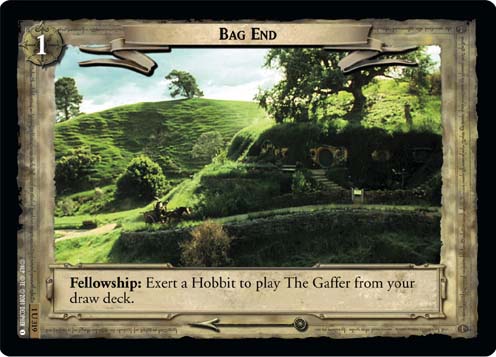 A site 2  At the start of the game, players choose a fellowship. A player’s fellowship consists of A Ringbearer (generally Frodo)  And, of course, The One Ring (of which there were different copies with different rarities- 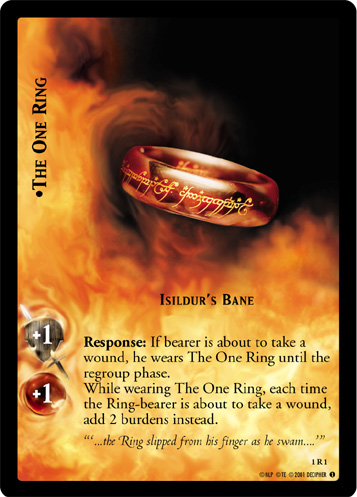 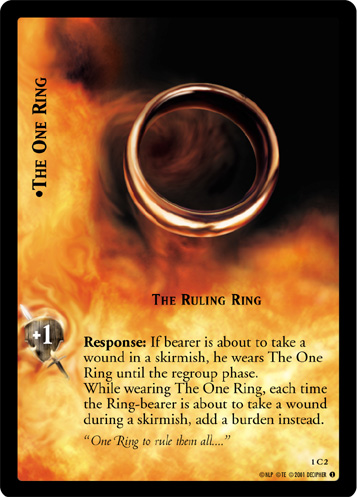 (unsurprisingly, the rare Ring was generally better than the common one) Along with 4 cost worth of companions Companions are generally the main characters from the movies, like Aragorn  Or Gimli- 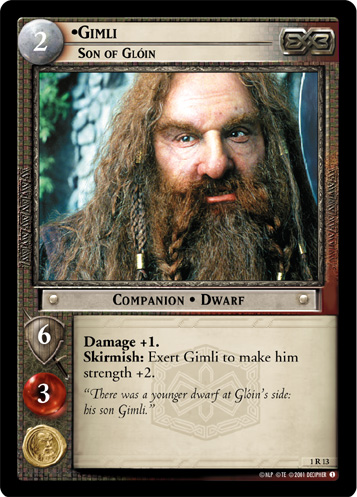 Characters (Companions and Allies, a card type I’ll discuss later) have 4 elements, A Cost, in the top left (Aragorn is 4 and Gimli is 2) A Culture, in the top right (used to trigger game effects) (Aragon is a Man and Gimli is a Dwarf) A Strength (the number in the shield) which represents how well they fight (Aragorn is 8 and Gimli is 6) And a Vitality (the number in the red/orange circle) (Aragorn is 4 and Gimli is 3) And may also have a signet (weird face-y thing in the bottom left) indicating a sort of “affiliation” separate from culture (Gimli and Aragon both have a Gandalf signet). Then, players bid burdens for the right to go first. Burdens represent corruption on the ringbearer, and, if your ringbearer ever has burdens equal to or greater than their resistance, you lose the game. The other way you lose the game is if your ringbearer is killed, so don’t let that happen. Bidding was quite a delicate art, since choosing sites can have a huge impact on your deck's performance, but overbidding can put you in a tough spot from the start. The player going first chooses what Site 1 to begin at. Importantly, once a site is in play, that site is the site for BOTH players (baring site control shenanigans). As an interesting catch-up mechanic, when a player moves to a number NOT YET on the board, their opponent gets to pick the site that they move to. For example, a player moving from Site 5- 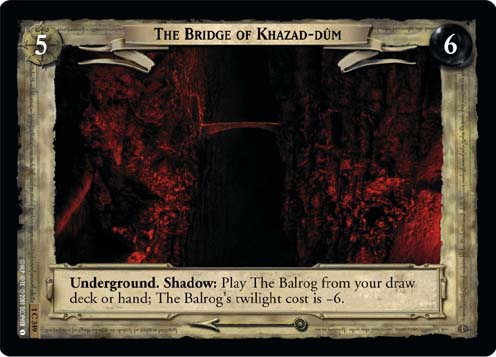 To an unknown Site 6 will have to deal with their opponent’s choice of Site 6, for example, 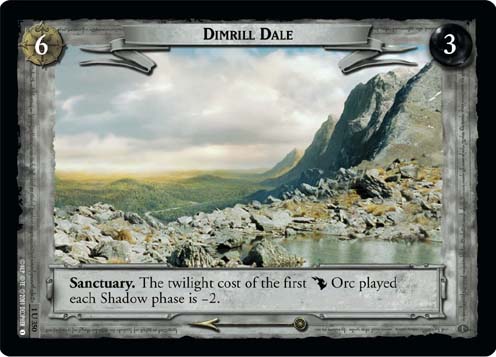 , which is likely to benefit someone playing a Moria Orc shadow deck, which is probably your opponent, and not, for example, someone playing a Nazgul shadow deck. , which is likely to benefit someone playing a Moria Orc shadow deck, which is probably your opponent, and not, for example, someone playing a Nazgul shadow deck. Anyway, back to the proper turn order. The first phase is the Fellowship phase. At the start of the phase, if you’re at a Sanctuary (Sites 3 and 6), you heal 5 wounds from your Companions. This is the only “default” healing that occurs (you can discard duplicate characters to heal during the Fellowship phase to heal a wound at any location, but that’s not super common), and ties into an aspect of the game’s action limits. Unlike other similar games, there’s no “tap” state, instead, cards Exert (take a wound) as a cost to activate actions. During this phase you can also take fellowship actions (actions that say Fellowship: ) and can play any number of fellowship cards. Each card played adds its cost to the Twilight Pool. The more stuff you play, the more “ammunition” you’re giving to the other player to throw back at you, so be careful about how much stuff you’re playing. Fellowship cards are Companions (discussed above), Conditions (similar to enchantments in something like Magic), Possessions (stuff your characters have), and Allies. Allies represent people your fellowship meets during the travel, but who do not adventure with you, like Elrond. They are an interesting hybrid, where they behave like Companions when you are at their home site (Elrond’s is 3), but are effectively Condition-like otherwise. 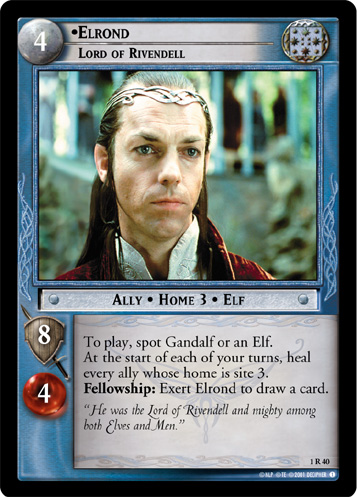 After you’re done playing things, you are forced to move to the next site. Sites have a default twilight number (in the upper right corner), which they add to the pool, and each companion in your fellowship also adds 1 twilight by virtue of existing. This acts as a balancing mechanism against having a really huge fellowship, and, it being a Decipher game, there were also a bunch of hoser cards designed to hurt large Fellowship strategies. The Shadow player (your opponent) now has a chance to use all of the twilight you generated to play minions , conditions and equipment. Minions have a “roaming” restriction that gives them +2 cost if they’re played to a site before their home site (the number in the bottom left), and the other cards generally have culture restrictions, where they require "spotting" an appropriate minion type, or only being allowed to be equipped by an appropriate minion. 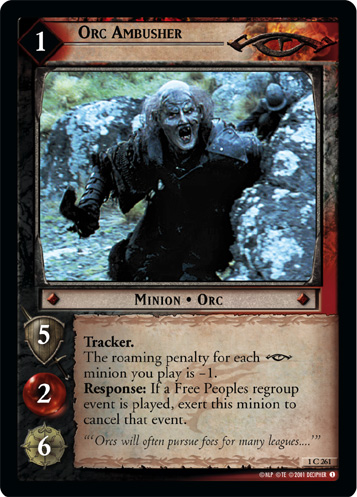 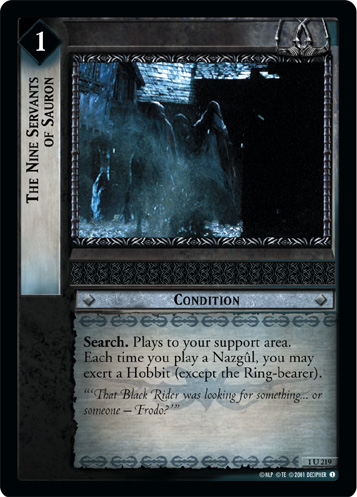 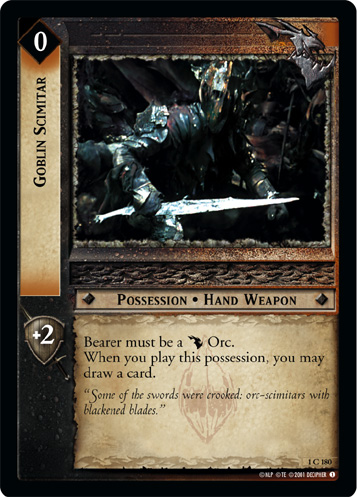 After the shadow player is done playing cards, both players’ archers fire, generating 1 wound that must be assigned for each character with the Archery tag. Next comes assignment, in which the Fellowship can assign any characters they control to minions. After the Fellowship is done assigning, any unassigned minions can be assigned by the shadow player as they choose. The Fellowship player then chooses the order in which the skirmishes resolve. In each skirmish, the strength totals of the two sides are compared, with the losing side taking a wound for each participating character (plus an additional wound for each damage +1 modifier on the winning side). If one side is at least twice as strong as the other side, the losing side is overwhelmed, causing all the losing characters to immediately die (this was an excellent way to kill a ringbearer, as otherwise they'd "put on the ring" and take burdens instead of wounds). After the main skirmish phase, there’s a second skirmish phase for Fierce minions, which is resolved in the same way. The shadow player then draws back up to 8 cards, and presents the Fellowship player with the most consequential decision of the game, whether or not to attempt a second move. If the fellowship moves again, they generate twilight again, all of the undefeated minions stick around for another round of attacks, AND the shadow player gets to play even more threats. However, double-moving is also key to actually winning the game, since the player who makes it to Site 9 first wins. Most well-built fellowships tended to try to double move on the first turn 1->2->3, since starting the next turn at a sanctuary gives a chance to heal before the next leg. Double-moving 3->4->5 could be quite risky, as you’re starting on a non-sanctuary, and the higher the site number, the more twilight the sites generated and the bigger the minions that would no-longer be “roaming”, but could be a good way to get a big advantage. Another consideration was the shadow player’s hand. Since the game was built around a hand-refill mechanic, a shadow player who played few cards in in the 1st move might have few shadow cards to attack during the second move. Normally players are restricted to only 2 moves, but some cards increase the move limit, allowing you to take advantage of a stumbling opponent and get really far ahead. When the fellowship player stops, they refill their hand to 8 cards, and play passes to the shadow player, who becomes the fellowship player. My experience with the game I played the game off and on during the Fellowship and Two Towers Blocks and a very small amount of play during the Return of the King Block. I was not very good, and mostly played with my family, though I did play a few times at the local Nebraska game-store. I felt that this game, out of all the Decipher TCGs, was the best balanced and the most interactive. Moreover, because of the aggressive focus on the main characters from the movies, even commons were playable in many decks. The core mechanics are interesting, and, if you were as into the Peter Jackson movies as I was, it’s fun to be able to “re-live” a bunch of your favorite moments. That said, I enjoyed this game a lot less than the other LoTR card game, mostly because the game was so focused around emulating the story of the movies rather than having your own adventures in Middle Earth. Also, it felt weird to have members of the Fellowship die partway through the story (I mean, members of the fellowship that aren’t wizards or Boromir). Finally, later sets (after the release of all of the LoTR movies) had huge changes to the rules, including the addition of alternate ringbearers (like Gandalf, Boromir, and Bilbo), the complete remapping of the cultures to a smaller set, and a change to the site rules that basically had the site deck be a set of 9 cards in arbitrary order, instead of the fixed 1-9 sets of sites in the movie blocks were enough to completely lose my interest in the game.
|
|
|
|
nomadotto posted:Two Fellowships were racing for the good of all mankind: The Decipher LoTR TCG Thank you very much for this write up. I don't remember seeing any game do the 'resource spent becoming opponent's resource' thing in any other game, though a few board games like Patchwork come kinda close. If I recall correctly, I seem to remember hearing that shadow cost reduction was super broken, and things like Bill the Pony got banned. And hey, it's something were you can use photos and it's alright and not super terrible because at least the photos are from a set of movies that are really pretty. And they even got some images that don't feature in the movies.
|
|
|
|
Magnetic North posted:Thank you very much for this write up. I don't remember seeing any game do the 'resource spent becoming opponent's resource' thing in any other game, though a few board games like Patchwork come kinda close. That mechanic is something that exists in the current Digimon Card Game. Not relevant to the thread (since it's still active and not particularly fringe), but essentially you have a sliding tracker of "memory" (mana essentially), from 10 on your side, to 10 on your opponent's side, and your turn ends when you spend (or lose) enough to go to your opponent's side, and they start their turn with that amount. Small difference is that it's not cumulative, if I'm at 1 memory and spend 2, that's it, my turn ends and my opponent is at 1, I can't play a big'un after that. Would Duel Masters be a fit for the thread? It's been discontinued twice in the West, but it's been going strong in Japan, with new sets coming out regularly (next one comes out on Saturday actually). EDIT: Also great write-ups for L5R and LotR. L5R especially always seemed pretty "Oooooooh" to me, with the two decks
|
|
|
|
Serperoth posted:Would Duel Masters be a fit for the thread? It's been discontinued twice in the West, but it's been going strong in Japan, with new sets coming out regularly (next one comes out on Saturday actually). Sure! If it doesn't already have its own thread, then go for it. I did a lap through this subforum to see what games had their own threads ahead of the OP, and I don't remember seeing a thread for Duel Masters.
|
|
|
|
Magnetic North posted:If I recall correctly, I seem to remember hearing that shadow cost reduction was super broken, and things like Bill the Pony got banned. Haaaaang on, do you mean to tell me Decipher actually figured out what a ban list is, and didn't just print "silver bullet" cards to try to deal with the problem?
|
|
|
|
Serperoth posted:That mechanic is something that exists in the current Digimon Card Game. Right. poo poo. I knew that. I noted that mechanism. I don't know much about Digimon but it honestly looks kinda sweet. How did I not put that together before now? Railing Kill posted:Sure! If it doesn't already have its own thread, then go for it. I did a lap through this subforum to see what games had their own threads ahead of the OP, and I don't remember seeing a thread for Duel Masters. The non-Magic card game threads I know of are: Pokemon LCGs Netrunner Flesh and Blood Keyforge B-Con? if that counts.
|
|
|
|
I'd love a duel masters write up. I didn't play too competitively the first time around with it so I probably can't do a write up outside of how to play, but it is my all time favorite tcg! Still waiting to see if wotc brings it back again for the 20th anniversary.
|
|
|
|
Railing Kill posted:Oh, and I'll send a PDF of the 7th Sea RPG house rules to Dawgstar via DM. If anyone else is curious, let me know here or via DM. I can't publish it, obviously, but I'm willing to give it out to those interested. Thanks! I appreciate that.
|
|
|
|
I always found it weird how the 7th Sea card game was all about the pirates when the rpg was much more about swashbucklign Musketeer style.
|
|
|
|
MonsieurChoc posted:I always found it weird how the 7th Sea card game was all about the pirates when the rpg was much more about swashbucklign Musketeer style. Zinzer said in interviews that the three CCG concepts early AEG had were just Samurai, Cowboys, and Pirates. I suspect the disconnect between the CCG and RPG can be owed entirely to John Wick, since the dude loves courtly intrigue and GMs being able to do mean things to their players. See also: the 7th Sea setting having no way to get to the new world,.the Asian ocean being cut off by a wall of flame, and no actual Carribean equivalent, thus having no actual functional analogue for any of the real world privateer and pirate poo poo.
|
|
|
|
Sega 32X posted:Zinzer said in interviews that the three CCG concepts early AEG had were just Samurai, Cowboys, and Pirates. I suspect the disconnect between the CCG and RPG can be owed entirely to John Wick, since the dude loves courtly intrigue and GMs being able to do mean things to their players. See also: the 7th Sea setting having no way to get to the new world,.the Asian ocean being cut off by a wall of flame, and no actual Carribean equivalent, thus having no actual functional analogue for any of the real world privateer and pirate poo poo. Yeah, I believe Wick's big idea for what turned into 7th Sea was the Vodacce, which is ruling noble houses intrigue backed by fortune-telling witches and I think he made a game that was basically that later. Even the pirate stuff they had was kind of limited. You had the Spanish Armada equivalent getting turned back by the British and related privateers, you had random pirates like Captain Reis and the Rogers, the not-Vikings who were handwaved to still do their thing thanks to weather magic plus some Enlightenment-esque pirate group that operated out of a former prison island but with nowhere to go but basically the continent's west coast there weren't a lot of meat on those bones.
|
|
|
|
Later on there was a place called the Midnight Archipelago, which was kind of like the Caribbean. There still wasn't an analogue to North America or South America, but it was better than what the first phase on first ed had for high seas adventure. Unfortunately, it was added in the second and third phase of the game's life, which is when the mechanics went to absolute poo poo.
|
|
|
|
Railing Kill posted:Unfortunately, it was added in the second and third phase of the game's life, which is when the mechanics went to absolute poo poo. Also when they decided to lean hard on the Syrneth(?) being weird alien bug gods trapped in wherever you go when you use Porte, yeah?
|
|
|
|
I really liked the concept of Swashbucklers vs. Cthulhu. It made an interesting campaign when the spellcasters finally fully realized what was powering their bloodline magic. That reveal was so much fun to run.
|
|
|
|
Magnetic North posted:And hey, it's something were you can use photos and it's alright and not super terrible because at least the photos are from a set of movies that are really pretty. And they even got some images that don't feature in the movies. Decipher had a Star Wars set, Reflections II, where they had characters from the Star Wars EU and used photographs of models dressed as the characters for the card art. Reflections I was a greatest hits set that had popular cards from previous sets, which they did for Star Trek too and oddly enough, named it Reflections. Lord of the Rings had a Reflections set, where in it was mainly popular and powerful cards and stuff like Radagast, Tom Bombadil, Goldberry, Elendil, and Freca for the first and only time outside of promos. I imagine they never did this for Star Trek, Paramount has a policy opposite of what LucasFilm had concerning the EU in that Star Trek novel stuff is just legally produced fanfiction with no larger acknowledgement beyond that. Tolkien's stuff was and is a rights nightmare so I imagine those deep cuts were the most they could get away with. There's also a card for Pallando, one of the two blue wizards, but it's represented by the moth that visits Gandalf while he's a prisoner in Orthanc. I had a bunch of LotR CCG cards up to around the Two Towers I think but I gave them all away since they were mostly worthless and taking up space. I did play it a fair deal so I at least feel like I got my value out of it. I still have all my Star Wars CCG cards, which I might flip one day, but I'm just sitting on them due to nostalgia value. I've been meaning to bust out my VTES cards with friends because I have about 14 decks or so and was really big into it in high school. I bought a box of the Black Hand set when it came out because at that point Sabbat stuff was out of print and hard to come by. The way VTES was printed in terms of sets made sense in a macro sense of the game but to a player, it was annoying as gently caress considering if you didn't get in on a set that had the clan or bloodline you wanted, you had to hunt down the starter decks or packs and/or pay a premium for them. EDIT: Thinking about Decipher and VTES reminded me that VTES handled the updated or more powerful versions of characters better than Decipher did. Decipher was always printing newer, better versions of character cards so it was always an arms race for that new version of Luke Skywalker, Jean Luc Picard, or whoever. LotR even had that to a degree in that there were multiple versions of characters but I don't remember it being as egregious as SW or ST. VTES would have advanced versions of crypt cards that were better than the original card but you could upgrade the old one in game for a small cost or you could just play the advanced for its full price. It was a much more player friendly system than Decipher's. RocknRollaAyatollah fucked around with this message at 00:10 on Sep 16, 2022 |
|
|
|
Dawgstar posted:Also when they decided to lean hard on the Syrneth(?) being weird alien bug gods trapped in wherever you go when you use Porte, yeah? Humbug Scoolbus posted:I really liked the concept of Swashbucklers vs. Cthulhu. It made an interesting campaign when the spellcasters finally fully realized what was powering their bloodline magic. That reveal was so much fun to run. Alright. 7th Sea spoiler corner: The Syrneth are actually five different races of non-human beings who ruled Theah in lost aeons past. Each one is responsible for a different sorcerous bloodline. Dragons are one, and are the source of El Fuego, for example. The insectoid ones are the source of Porte, and they are trapped in the space-between-space. All Bargain sorceries -- Porte, Sorte, El Fuego, Nacht, and Eisen's extinct Zerstorrong -- tear at the fabric of the barrier holding the Syrneth collectively at bay. Glamour, Pyeryem, and Laerdom do not, but do come from the fae, or beings like them, who are also inhuman and happen to be in an eternal beef with the Syrneth. They are friendly toward humans only comparatively to the Syrneth. Oh, also there is a frozen lake in Ussura which hides a frozen but otherwise intact and living Syrneth civilization. Oops! Oh, and one more thing about humans in 7th Sea: they have their own magic, and that is the great secret of the Knight of the Rose and Cross. They don't know why it's important to have natural human magic, but they know what it is. Other secret societies know bits and pieces about all of this, but no one has all the pieces in one place. None of this has any bearing on the CCG. RocknRollaAyatollah posted:I've been meaning to bust out my VTES cards with friends because I have about 14 decks or so and was really big into it in high school. I bought a box of the Black Hand set when it came out because at that point Sabbat stuff was out of print and hard to come by. The way VTES was printed in terms of sets made sense in a macro sense of the game but to a player, it was annoying as gently caress considering if you didn't get in on a set that had the clan or bloodline you wanted, you had to hunt down the starter decks or packs and/or pay a premium for them. Yeah. Some of the important NPCs form the tabletop game got printings in the CCG, and "advanced" versions too. The advanced versions weren't necessarily better than the basic versions, so it depended on what you were planning to do with their abilities. You could run either version by themselves, but fi you paid 1 pool with either version in play, you could "merge" them if you had the other in your uncontrolled region. The advanced version had a third ability that you got only if you merged the two, so you ended up with the abilities of both, plus a bonus. It's less OP than it sounds, because this required you to have both of them in play, which is half of the four vampires you have to choose from at the start of a game. You could pay pool and spend turns digging for more, but that often cost time and resources players couldn't spend. You got an ample reward for building around an advanced vampire and jumping through the hoops. But I wouldn't say it was a common strategy for decks to take because of those hoops. Randalor posted:Can you cover what the clans are good at? Specifically the 5th edition clans because that seems like the easiest 'entry point' for new players? I'm on it. I have some extra free time today, so I'll work on a post about clans, sects, and how they influence deckbuilding.
|
|
|
|
Railing Kill posted:Alright. 7th Sea spoiler corner: Huh, I guess that's where L5R got their similar plot twist that came out of nowhere.
|
|
|
|
So only tangentially related to card games, but how bad were the old World of Darkness novels? The local charity book fair was on this weekend and they had a bunch of Vampire and Rage novels, including the complete 13 Clan series. I bought them all, how much pain am I in for when I start reading them?
|
|
|
|
Randalor posted:So only tangentially related to card games, but how bad were the old World of Darkness novels? The local charity book fair was on this weekend and they had a bunch of Vampire and Rage novels, including the complete 13 Clan series. Most are very bad indeed. The first two (Toreador and Tzimsice) especially, the former seemingly spends most of its word count dedicated to telling you how hot its lead character is and even makes ancient vampires horny even though they shouldn't be and the latter is just a... really, really bad novel. The others range from 'pretty bad' to 'mediocre' to the two by Kathleen Ryan (Setite and Ravnos) which are 'not too bad, considering.' The only genuinely good WW novels I'd recommend without reservation are, oddly, the Demon: The Fallen novels but they were all written by Greg Stolze.
|
|
|
|
Darn. Ah well, the money goes to a good cause and it'll give me something to read at work. Worst case scenario, I'll have handy projectiles to whip at people's heads that I won't care about.
|
|
|
|

|
| # ? May 30, 2024 00:08 |
|
Sects and Violence: Clans and Disciplines in VTES VTES effortpost one: the basics VTES effortpost two: card roles Effortpost four: deckbuilding Before I get into clans, let me give a more zoomed-out rundown of disciplines than the last post. The last post was more about granular mechanics. This is more about how disciplines shape clans and deckbuilding. But here's a reminder of the stuff every deck needs to be ready to handle: Payload: damaging your prey's pool Delivery: how you get through to your prey Combat: killing opponent's minions, or at least not getting killed yourself Defense: making sure your minions are ready and able to defend your pool Resource management: getting more blood to your minions, and more pool to you VTES has a staggering number of disciplines (29). However, I'll put them all in three more manageable categories: Core Disciplines: These are the ones that multiple clans have in-clan, i.e. that most of that clan's vampires have them. EAch clan has three in-clan disciplines that you can count on building around if you're running that clan. These core disciplines are the most common, and are therefore foundational to most deck strategies. The game isn't going to stick the important, meat n' potatoes poo poo to disciplines that only a handful of printed vampires have. These are the disciplines you need to at least know vaguely in order to play the game. You don't need to memorize every card, but you need ot know what to expect from each of these like you would need to know what green or red can do in MTG. The core disciplines are: Animalism: a toolbox discipline, although commonly used for defense and combat Auspex: defense Celerity: combat Dominate: payload and resource management Fortitude: combat Obfuscate: delivery Potence: combat Presence: payload and resource management Specialty Disciplines: These are disciplines native to one clan, but which can be found elsewhere somewhat often. New players could mistake them for core disciplines pretty easily and understandably, but their occurrence on cards is lower than a core discipline. More importantly, their use is less narrow than a core discipline. Here is where we start trading frequency for utility. So keep in mind that, in addition to the strengths listed below, these disciplines have more range than core disciplines beyond their strengths. Newer players would want to acquaint themselves with the one(s) they are using, but wouldn't necessarily need to know the comprehensive abilities of each of these to be competitive. (But obviously, more knowledge is always good!) Specialty disciplines are: Chimestry (illusion): delivery Dementation (madness): payload Necromancy (death/ghosts): delivery Obtenebration (shadows): delivery, combat Protean (shapeshifting): delivery, combat Quietus (blood): combat Serpentis (corruption): payload Thaumaturgy (sorcery): combat Vicissitude (flesh crafting): combat Fringe Disciplines: These are possessed by one clan, that clan is few in number, and these disciplines are usually only possessed by members of that clan so you will rarely find it out of clan. So stepping deeper into trading frequency for utility, these disciplines can do a lot of work in exchange for their rarity. They often set up combo synergies with their clans' other disciplines and have some mechanics you can build whole decks around. You don't need access to this kind of stuff to build a good deck, though! They're just there as options for more experienced players to goof around with combos and stretching the usual uses of other disciplines. They are: Abombwe (shapeshifting): defense Daimonion (infernalism): toolbox Melpolminee (voice): payload Mytherceria (fae magic): delivery Obeah (soul magic): resource management Sanguinus (blood/body sharing): combat Spiritus (spirits): defense Strigia (infernal sorcery): combat Temporis (time): toolbox Thanatosis (decay): resource management Valeren (warrior): combat Viseratika (gargoyles): defense, combat Hilariously, Strigia stands out as the most bespoke, hipster-rear end discipline ever printed, as there are 0 vampires printed with Strigia. Instead, you need to play special cards to give a vampire Strigia. But wait! It can't be just any ol' dumbass. It has to be an infernal vampire, which is itself rare. So there was one set with a bunch of Strigia cards printed to which a lot of folks said, "ehhhh....no." That just gives you an idea of how deep the rabbit hole can go with the exclusivity of some of these fringe disciplines. Anyway, so now you have a bird's eye view of each discipline and what they do for a deck. With that in mind, let's look at the clans by way of their in-clan disciplines. Clans shape a deck by two ways: providing three in-clan disciplines that tend to be printed on the clan's vampires, and by providing clan-only cards that require at least one of that clan ready on your side to play the card. The clan-specific cards often provide a necessary resource common to most decks (hunting grounds that provide free blood, for example), but they can also lean into a clan's specialties (providing stealth to a clan which already has Obfuscate in-clan, for example). But let's focus on the in-clan disciplines because that's the majority of a deck's construction. A clan's three-discipline spread tells you most of what you need to know about what they're good at, and what they're not so hot at. VTES' clans are divided into four political sects. These are from Masquerade lore and I won't get too much into that here. All you need to know about them is that it is yet another modifier to what a card might require. A card might call for a discipline, a clan, or a sect. Each sect also has voters, vampires with titles that give them power during political actions. For now, I'll just use sects to organize the clan lists. I'll also put **asterisks** next to the clans that are more fringe (who tend to have the aforementioned fringe disciplines and don't come up as often as the bigger clans. These ones can be set aside for newer players just trying to process information without going Camarilla Sect: The game's default political organization, run by elders and built upon age and old power and exclusivity. The game's most numerous clans fall within this group, and it is the easiest jumping off point for a new player. That is not to say these clans are necessarily simple or mechanically weak, but they just are more accessible.  Brujah: Celerity, Potence, Presence. Great at combat, with a premiere payload discipline in Presence. The prototypical beat-and-bleed clan. They lack a good defense in-clan, which people often supplement with either sect cards (like The Second tradition), or a fourth discipline (like splashing Auspex and teaming them up with some Toreador, for example).  Malkavian: Auspex, Dementation, Obfuscate. Great at both payload and delivery. They are the prototypical stealth-bleed clan. Auspex can block or misdirect your predator too. Combat is their weakness, as they lack a good offense, defense, or way out of combat.  Nosferatu: Animalism, Obfuscate, Potence. Good on defense, great on delivery, and even better in combat. They lack a strong payload, which is often supplemented with equipment or by combat punishment combos.  Toreador: Auspex, Celerity, Presence. Good at defense, payload, and combat. An almost complete lack of delivery means they need ot lean on celerity and weapons to beat bleeds through, or get tricky with political actions.  Tremere: Auspex, Dominate, Thaumaturgy. Good on both defense and payload, similarly to the Toreador. Thaumaturgy is toolboxy and can handle combat as well as supplement payload and defense. They still lack a delivery mechanism and Thaum is sometimes card-intensive, so people usually use quite a bit of Thaumatuirgy with them to solve these problems by beat-bleed or by toolbox combos.  Ventrue: Dominate, Fortitude, Presence. Top-notch payload and resource management. They lack a clear defense, so this is the clan people often use to defend themselves by way of resource management: outpace your predator by gaining more pool than you lose. Sabbat Sect: The "bad guys" according to the Camarilla. The Sabbat was originally an uprising against elder rule, but quickly devolved into carnage, religiosity, and...well look at that! Rule by elders all over again. Oops! Many Sabbat clans are identical to their Camarilla siblings in terms of clan disciplines, but there are a few Sabbat-exclusive clans. Besides the Antitribu, the Lassombra and Tzimisce are probably the most accessible ones to new players.  **Ahrimane: Animalism, Presence, Spiritus. Excellent as defense and Spiritus can do some weird poo poo in combat. Presence and Spiritus can also do decent resource management together. While they can get stealth, it is a bit light, so these decks often run a good combat suite.  **Blood Brother: Fortitude, Potence, Sanguinus. Combat monsters. All three of their in-clans are combat disciplines. Sanguinus does other stuff, mostly resource managment. With virtually no payload or delivery, most decks run every combat punishment combo they can get their grubby mitts on.  Gangrel Antitribu: Celerity, Obfuscate, Protean. Excellent delivery but next to no payload. Protean is very dangerous in combat too, if they can catch opponents or be caught. Like the Nosferatu, a lot fo the payload can be supplemented by equipment. NOTE: the independent Gangrel have a different discipline spread: Animalism, Fortitude, and Protean. In the CCG, the two are treated as different clans. The "city Gangrel" with Celerity, Obfuscate, and Protean tend to be sabbat, while the "country Gangrel" tend to be independent.  **Harbinger of Skulls: Auspex, Fortitude, Necromancy. Very defensive, both for the player and the minions. Necro can do decent resource management too. With little offense in combat and no payload discipline, they often aim to make games an attritional resource war.  **Kiasyd: Dominate, Mytherceria, Obtenebration. Potentially defensive if Mytherceria is tuned toward intercept, but people usually tune it more toward stealth to go with Dominate's bleeds. Combat is often a weakness, but Mytherceria is rare enough to have some answers for anything if you're willing to pack them.  Lassombra: Dominate, Obtenebration, Potence. They can do stealth-bleed or beat-bleed, both of which are powerful options. Aside from deflecting bleeds out of Dominate, they lack a consistent defense.  **Salubri Antitribu: Auspex, Fortitude, Valeren. Good at getting into combat by way of blocking or by directly "rushing" minions through Valeren. Once in combat, they are stacked for both attack and defense. They lack consistency in both payload and delivery though, so they often end up a lot like the Blood Brothers and doing weird combat tricks and running a huge suite of pool punishment for combat losses.  Tzimisce: Animalism, Auspex, Vicissitude. Excellent at defense between Auspex and Animalism, and great in combat between Vicissitude and Animalism. They are usually run as a counterpuncher, blocking and killing opponents' minions before attacking with their comparatively light payload.  ___ Antitribu: these are Sabbat sect versions of the Camarilla clans. Importantly,  VTES treats them as a seperate clan as their cam counterparts! VTES treats them as a seperate clan as their cam counterparts! They usually have the same clan disciplines (except where I noted above) but their clan and sect cards are different. So, you can easily mix them in with cam vampires because they share disciplines, but you just have to be careful about clan cards. They usually have the same clan disciplines (except where I noted above) but their clan and sect cards are different. So, you can easily mix them in with cam vampires because they share disciplines, but you just have to be careful about clan cards.Independent Sect: Clans not aligned with the Camarilla or the Sabbat. This is more of a catch-all category of clans with individual dealings with the other sects, rather than an organized bloc on their own. They can (and do) do politics and have voting minions, but they just have very few cards that call for an independent vampire. The core four are Assamites, Followers of Set, Giovanni, and Ravnos, but Gangrel went independent later as they left the Camarilla in the middle of the CCGs life. Every other clan here is pretty fringe and can be safely ignored for a new player.  **Abomination: (no clan disciplines). These are vampiric werewolves, the result of  Assamite/Banu Haqim: Celerity, Obfuscate, Quietus. Assamites are good at combat and stealth, but usually lack payload. People often supplement this by spashing ina fourth discipline like Presence, or by running combos of cards that punish the loss of minions.  **Baali: Daimonion, Obfuscate, Presence. They have payload and delivery and a wide-ranging discipline in Daimonion. They're a bit light on defense but otherwise seem to lack a weakness. The downside is that they are all infernal, which means you pay pool every turn or else they tap down. You get what you pay for.  **Daughter of Cacophony: Fortitude, Melpolmonee, Presence. Good at payload, particularly in political actions. They can stand up in combat, but can't necessarily dish it out. No great options for defense, though.  Follower of Set/Ministry: Obfuscate, Presence, Serpentis. Great at both payload and delivery, and pretty good at resource management. Presence is often used to get out of combat ASAP, although there is a suite of cards in Serpentis that can by used to make a combat deck instead. However, they offer next to nothing in defending you, the player who pays pool for them. Using resource management to outpace your losses is a good bet.  Gangrel: Animalism, Fortitude, Protean. Good at defense, combat, and resource management. Decent at delivery by way of Protean's stealth. They lack a payload, which is sometimes overcome by sheer volume or by clan/sect cards. NOTE: you will sometimes see Camarilla Gangrel printed before the clan left the Cam in the late 1990's/early 2000's. These cards are just as they are printed, such as my girl Stanislava at the top of the first effortpost.  **Gargoyle: Fortitude, Potence, Viseratika. Top-tier combat, with some help form Viseratika in both defense and delivery. Nothing in any of these disciplines does anything for payload, though, so go with the ol' punishment suite for killing minions. They are also often paired with Tremere to capitalize on their slave mechanic to swap them out of a Tremere's combat, but that requires a deck to be ready to run at least four disciplines to do that well. The idea is that tyou power-bleed with a Tremere's Dominate, and then have a Gargoyle take the combat if they are blocked. It works, but it is as janky and card intensive as it sounds. 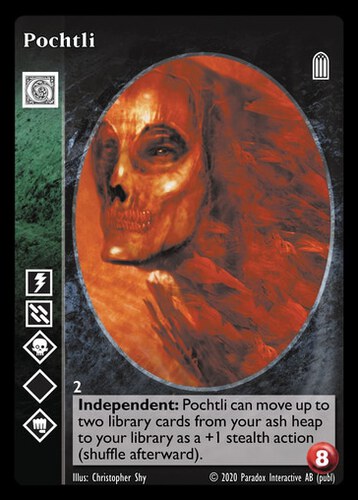 Giovanni: Dominate, Necromancy, Potence. Great at payload and resource management. Good at delivery too. While no slouch in combat, they are a bit of a glass cannon with nothing to defend them in combat like Celerity or Fortitude. That, and being a bit light on pool defense are their weaknesses.  **Nagaraja: Auspex, Dominate, Necromancy. A lot like the Kiasyd, actually. Necro is a good toolbox to supplement their defensive and delivery options, and Dominate is maybe the best payload discipline. Since they are very few in number, they often get splashed into Giovanni decks to give them some pool defense.  Ravnos: Animalism, Chimestry, Fortitude. Good at defense, great at delivery. Sneaky good in combat by way of using Animalism and Fortitude to turn combats into attritional grinds. Out of combat, they can be explosive, with some ways to shut down minions entirely outside of combat. Again, a lack of payload often means using equipment or running a Chimestry combo package.  **Salubri: Auspex, Fortitude, Obeah. Excellent at defense and resource management. Obeah has some powerful effects that top the resource management power level. They can survive combat but can't do much else without a fourth discipline. They also lack payload. They are scarce and meant to splash into other decks to add resource management and defense to clans with Fortitude and/or Auspex.  **Samedi: Fortitude, Obfuscate, Thanatosis. Great at both stealth and combat, and good at resource management. They can also do some wild poo poo with minions using Thanatosis, including raising armies of zombies. This volume can supplement their lack of payload.  **True Brujah: Potence, Presence, Temporis. Like their younger cousins, they do beat/bleed very well with strong combat and strong payload. Temporis is rare so it is a wide toolbox, but offers little in the way of stealth. Trujah often have nutty abilties that whole decks can be built around, so the use of Temporis often differs wildly depending on who is in the deck. Laibon Sect: Four clans originating in Africa. They have their own political sect, the Laibon, with its own group of cards that call for this sect designation. Most, but not all, of the vampires from these clans are Laibon. The Laibon clans got two of their own sets (and maybe a third since I stopped collecting?) and while there is plenty of support for them, a new player could easily ignore them until they get familiar with the clans in more numerous sets.  **Akunanse: Abombwe, Animalism, Fortitude. Excellent at defense, combat, and resource management. Very little payload, but some unique options to punishing combat can make up for it.  **Guruhi: Animalism, Potence, Presence. Good for both beat/bleed and politics. Their resource management is top-notch too. They have absolutely no options for delivery, so the bit of stealth from politics or just sheer combat menace tries to get the job done.  **Ishtarri: Celetiry, Fortitude, Presence. Great payload and decent resource management out of Presence. Good combat defense too, but has to lean heavily on volume strikes and equipment to deal damage in combat. They lack a good means of pool defense pretty hard, though.  **Osebo: Auspex, Celerity, Potence. Great at defense, and even better in combat once blocking. Osebo almost always pack active combat entry alongside blocking into combat, since they lack both payload and delivery. A deep punishment block to hurt opponents by way of combat is necessary. I'll leave it there for now. With all of the info from the last few posts, I may make the next post a decklist or two, just to show in practice what a lot of this stuff ends up looking like. The decks will provide examples of clan strengths in action as well as building to cover up deficincies. They can also show some of the deck archetypes like stealth-bleed, beat-bleed, poltiics, etc., and the dynamics between them. Railing Kill fucked around with this message at 19:06 on Oct 1, 2022 |
|
|























